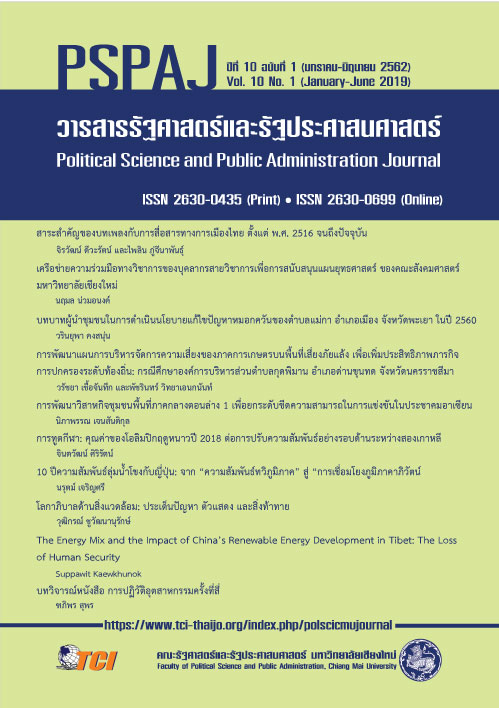The Development of Risk Management Plan of Agricultural Sector in Drought Risk Areas. An Approach to Optimize the Local Governance: A Case Study of Kudpiman Sub-district Administrative Organization, Tambon Kud Piman, Amphoe Dan Khun Thot, Nakhon Ratchasima Province
Main Article Content
Abstract
This research aims to 1) investigate risk components of agricultural sector in drought risk areas, and 2) to conduct the risk management plan of agricultural sector in drought risk areas. Participatory Action Research (PAR) was applied to the study. Group interview and in-depth interview are used as research instrument to collect primary data from key informants. The key informants of the research included (1) fifteen of farmers who suffered from drought, (2) fifteen of community leaders including village headmen, village committee, members of the Sub-district Administrative Organization Council, community seniors, Philosopher, resource person, Religious leaders, and leaders of the local organization were responsible for risk management of agricultural sector.
The study area is a village affected by drought more than three times within the last five years (B.E. 2013 - 2017). Data collection was conducted during March 2017 to February 2018 in Samnakpiman Village, where located at Moo 12, administrative Region of Kudpiman Sub-district Administrative Organization, Gudpiman Subdistrict, Dan Khun Thot District, Nakhon Ratchasima Province, and the location was in the drought risk area. Data then was analyzed by Descriptive Analysis method.
Research results found that
(1) Risk components of agricultural sector in drought risk areas;
consist of
(1.1) Vulnerability of agricultural sector was divided into 2 types include physical vulnerability and social vulnerability. Physical vulnerability consist of cultivation in drought risk area, no water source within
community, lack of water source, and cultivation outside irrigated area. Social vulnerability consisted of ambiguity of information, Inadequate support for government knowledge, and having attitude of believing in fate, drought warning data cannot be predicted accurately, focus on the low-level career integration, and lack of the supporting network.
(1.2) Potentials of drought mitigation consisted of development of cultivating diversification, management on farmlands, adaptation of cultivating period, constructing water source within community, mining, and regulating disciplines within community.
(2) Risk management plan of agricultural sector in drought risk areas
Risk management plan of agricultural sector in drought risk areas including providing knowledge of plant species cultivated and large scale production in drought risk areas, promoting the pilot farm, improvement
of new-generation farmers, assessment of drought risk, improvement of the forecast data, collaborations between related agencies, promotion on community participation, and training on leadership to cope with drought.
Article Details
- เนื้อหาและข้อมูลที่ลงตีพิมพ์ในวารสารรัฐศาสตร์และรัฐประศาสนศาสตร์ถือเป็นข้อคิดเห็นและความรับผิดชอบของผู้เขียนบทความโดยตรง ซึ่งกองบรรณาธิการวารสารรัฐศาสตร์และรัฐประศาสนศาสตร์ ไม่จำเป็นต้องเห็นด้วย หรือร่วมรับผิดชอบใดๆ
- บทความและข้อมูล ที่ได้รับการตีพิมพ์ในวารสารรัฐศาสตร์และรัฐประศาสนศาสตร์ ถือเป็นลิขสิทธิ์ของวารสาร หากบุคคลหรือหน่วยงานใดต้องการนำข้อมูลไปใช้ประโยชน์ในทางวิชาการ ขอให้อ้างอิงแหล่งที่มาด้วย
References
กรมป้องกันและบรรเทาสาธารณภัย. (2551). รายงานผลการดำเนินงานสงเคราะห์ช่วยเหลือผู้ประสบภัย ประจำปีงบประมาณ 2551. กรุงเทพฯ: กรมป้องกันและบรรเทาสาธารณภัย กระทรวงมหาดไทย.
______. (2552). คู่มือประชาชนในการเตรียมตัวให้รอดปลอดภัยพิบัติ. กรุงเทพฯ: กรมป้องกันและบรรเทาสาธารณภัย กระทรวงมหาดไทย.
______. (2558). แผนการป้องกันและบรรเทาสาธารณภัยแห่งชาติ พ.ศ. 2558. กรุงเทพฯ: กรมป้องกันและบรรเทาสาธารณภัย กระทรวงมหาดไทย.
กรมส่งเสริมคุณภาพสิ่งแวดล้อม. (2551). ภัยแล้ง. สืบค้นเมื่อ 7 เมษายน 2559, จาก https://dmd.mod.go.th/dryseason/pdf/1.aspx
พระราชบัญญัติสภาตำบลและองค์การบริหารส่วนตำบล พ.ศ. 2537 และแก้ไขเพิ่มเติม (ฉบับที่ 3 พ.ศ. 2542). สืบค้นเมื่อ 8 พฤษภาคม 2560, จาก www.khuanpang.go.th/prb.pdf
พฤทธิพงศ์ ทัศน์อัญชุลีกุล, ชฎาพร งามเขียว, และเมธี วุฒิเจริญ. (2556). การพัฒนาแหล่งน้ำและบริหารจัดการน้ำแบบมีส่วนร่วมในการแก้ไขปัญหาภัยแล้ง โครงการส่งน้ำและบำรุงรักษาแม่ยม จังหวัดแพร่. สืบค้นเมื่อ 15 ตุลาคม 2560, จาก https://dspace.tarr.arda.or.th/handle/6622815955/14257
สุพจน์ ชูรัตน์. (2553). รูปแบบการบริหารจัดการงานป้องกันและบรรเทาสาธารณภัยแล้งที่สอดคล้องกับความต้องการของประชาชนในเขตเทศบาลตำบลนาหว้าใหญ่ อำเภอปทุมราชวงศา จังหวัดอำนาจเจริญ. สืบค้นเมื่อ 15 ตุลาคม 2560, จาก www.ptu.ac.th/StudentServe/input/thesis/[10][200916105735].pdf
สุรพันธ์ สันติยานนท์. (2548). การวิเคราะห์และเตือนภัยแล้งโดยใช้ระบบสารสนเทศภูมิศาสตร์. สืบค้นเมื่อ 18 เมษายน 2559, จาก https://ir.swu.ac.th/xmlui/bitstream/handle/123456789/2633/Sawettachat_S_R417912.pdf?sequence=1
สำนักงานเกษตรจังหวัดนครราชสีมา. (2559). แบบเสนอขอโครงการตามแผนปฏิบัติราชการประจำปีงบประมาณ พ.ศ. 2560. นครราชสีมา: สำนักงานเกษตรจังหวัดนครราชสีมา.
สำนักงานป้องกันและบรรเทาสาธารณภัยจังหวัดนครราชสีมา. (2559). สรุปพื้นที่ประสบภัยพิบัติ ประจำปี 2557-2559. นครราชสีมา: สำนักงานป้องกันและบรรเทาสาธารณภัยจังหวัดนครราชสีมา.
อธิกสิทธิ์ วิเศษกลิ่น. (2555). การศึกษาปัญหาและอุปสรรคในการดาเนินการป้องกันภัยแล้งในเขตพื้นที่ตำบลบ้านวัง อำเภอโนนไทย จังหวัดนครราชสีมา. (วิทยานิพนธ์วิศวกรรมศาสตร์ มหาบัณฑิต), มหาวิทยาลัยเทคโนโลยีสุรนารี.
Baas, S., Ramasamy, S., Pryck, J. D., & Battista, F. (2008). Disaster risk management systems analysis. Rome: Food and Agriculture Organization of the United Nations.
Central Board of Secondary Education. (2006). Natural Hazards and Disaster Management. Shakarpur, Delhi: Chandu Press.
World Meteorological Organization. (2006). Social Aspects and Stakeholder Involvement in Integrated Flood Management Geneva, Switzerland. Retrieved November 21, 2011, from www.apfm.info/pdf/ifm_social_aspects.pdf
Wu, H., & Wilhite, D. A. (2004). An Operational Agricultural Drought Risk Assessment Model for Nebraska, USA. Natural Hazards, 33(1), 1-21.


